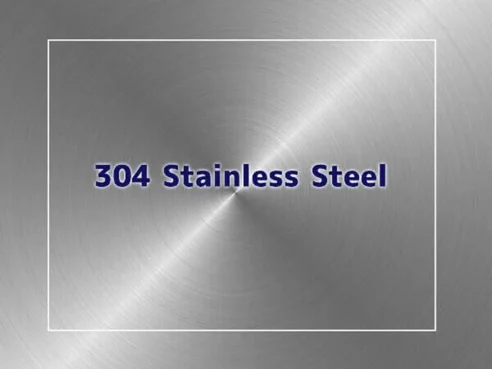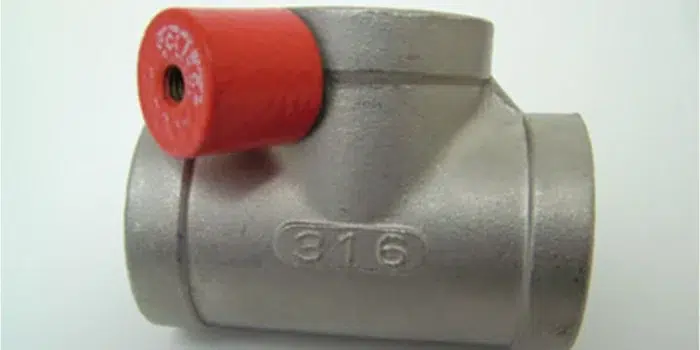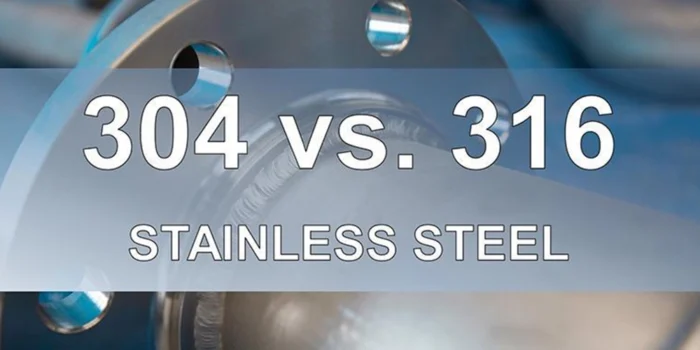Have you ever wondered if your stainless steel can rust? It’s a common question, especially when it comes to 304 stainless steel, one of the most popular grades used in various industries. In this blog, we’ll explore the truth behind 304 stainless steel and its rust resistance.
What is 304 Stainless Steel?
304 stainless steel, commonly referred to as AISI 304, is an austenitic stainless steel alloy recognized for its exceptional resistance to corrosion and oxidation, making it a popular choice in various industries, including construction, food processing, architecture, and medical applications. Primarily composed of a minimum of 18% chromium and 8% nickel, 304 stainless steel forms a protective oxide layer that helps to prevent rusting and extends the material lifespan in many environments.
Despite 304 steel’s reputation for durability, “stainless steel” is not absolutely stainless, but refers to the corrosion resistance is better than ordinary steel, the actual use of rust is still possible.Under certain conditions, such as exposure to chlorides and high humidity, it can corrode and develop surface rust.

Why is 304 Stainless Steel Resistant to Rust?
304 스테인리스 스틸 contains chromium (≥ 18%) and nickel (≥ 8%). When exposed to oxygen, chromium forms a thin, invisible layer of chromium oxide on the surface. This “passive layer” acts as a shield, preventing oxygen and moisture from entering the iron layer below, which is the typical cause of rust. As long as this layer remains intact, 304 stainless steel will not rust.
화학 성분
| 등급 | C | Si | Mn | P | S | Ni | Cr | Mo |
| 304 | ≤0.08 | ≤1.0 | ≤2.0 | ≤0.045 | ≤0.03 | 8.0-11.0 | 18.0-20.0 | - |
The presence of chromium is particularly important, as it forms a passive oxide layer on the surface, providing a barrier against further oxidation and corrosion. This passive layer can regenerate itself even after being damaged, which contributes to the longevity and durability of the material.
Can 304 Stainless Steel Rust?
Despite 304 steel’s reputation for durability, “stainless steel” is not stainless, but refers to the corrosion resistance is better than ordinary steel, the actual use of rust is still possible. Under certain conditions, such as exposure to chlorides and high humidity, it can corrode and develop surface rust.
The outstanding properties of 304 stainless steel include its strength, formability, and ease of cleaning, which contribute to its widespread use. However, various forms of corrosion can compromise its integrity, including pitting corrosion, crevice corrosion, bimetallic corrosion, and stress corrosion cracking (SCC).
Types of Corrosion
1. Pitting Corrosion
Pitting is a form of localized corrosion that is particularly damaging to 304 stainless steel, especially in chloride-rich environments such as seawater. The passive chromium oxide layer that provides corrosion resistance can be compromised by chlorides, resulting in the formation of small pits on the steel surface.
Once initiated, pitting corrosion can progress rapidly, threatening the structural integrity of the metal.
2. Crevice Corrosion
Crevice corrosion occurs in confined spaces where oxygen is limited, such as under gaskets or in gaps between parts. Chlorides tend to accumulate in these areas, destroying the protective passivation layer and accelerating the corrosion process. Oxygen deficiency combined with high chloride concentrations makes these locations particularly susceptible to corrosion.
3. Bimetallic Corrosion
Bimetallic corrosion, also known as galvanic corrosion, is the corrosion of 304 stainless steel that occurs when it comes into contact with another metal in the presence of an electrolyte, such as water. This interaction will form a primary cell, accelerating the corrosion of the less noble metal therein.
To mitigate this risk, it is advisable to use compatible metals or insulating materials to prevent direct contact between dissimilar metals.
4. Stress Corrosion Cracking (SCC)
Stress Corrosion Cracking (SCC) is a severe form of corrosion that occurs when mechanical stresses coexist with a corrosive environment, usually rich in chlorides. Pitting usually precedes SCC and pits act as stress concentrators.As mechanical stress is applied, these pits can expand into cracks and eventually lead to material failure. Preventive measures include reducing mechanical stress and selecting materials that are less sensitive to SCC.
Common Causes of Rust
Although 304 stainless steel is known for its corrosion resistance, it can still rust under certain conditions. Factors that can damage the passivation layer and lead to rusting include:
1. Chloride Corrosion
The concentration of chlorine ion resistance is only 20.5 ppm at 80℃. When exposed to chlorinated environments such as table salt, seawater, sweat, etc., chloride ions can damage the passivation films, leading to localized corrosion (e.g., pitting, intergranular corrosion), or even rust or mildew stains.
For example, in marine or chloride-rich environments, the risk of pitting and crevice corrosion increases significantly due to the aggressive nature of these conditions.
2. Environmental Factors
The environment plays an important role in the rusting process of stainless steel. Long-term exposure to high humidity, high salinity (such as coastal areas), strong acids and alkalis (such as hydrochloric acid, sulfuric acid) or high-temperature environments will accelerate corrosion.
Industrial pollutants, including sulfur compounds, can also contribute to corrosion by creating sulfuric acid on the surface of stainless steel.
3. Mechanical Damage
- Mechanical scratches, dents, abrasions, welding or cutting can damage the passivation film, making the exposed base stainless metal susceptible to rusting in wet/corrosive environments. Welded areas are most susceptible to intergranular corrosion.
- Residual contaminants on the surface (oil, cement, acidic liquids, etc.) that are not cleaned up on time, or long-term accumulation of water to form water stains, may induce rust corrosion.
4. Material Defects
Inferior 304 stainless steel may have reduced corrosion resistance due to substandard alloy compositions (e.g., insufficient chromium/nickel), inadequate solution treatment, or intergranular corrosion tendencies.
How to Prevent Rust on 304 Steel
Rust can form on the surface of 304 stainless steel when exposed to oxygen and moisture, especially if contaminated with substances such as salt or chlorides. Regular cleaning and maintenance, with the use of specialized stainless steel cleaners, will help remove surface rust and prevent further corrosion.

Preventive Measures
1.Environmental Control:
Avoid exposure to chloride ions (e.g., keep away from seawater, dry salt/sweat stains promptly) and keep the environment dry.
2. Surface Protection
Clean and dry the surface thoroughly regularly to avoid mechanical damage; passivation treatment should be done at the welding place.
3. Material Selection
Coastal or industrial areas are recommended to use more corrosion-resistant 316 stainless steel, or ensure that the composition of 304 stainless steel is up to standard.
4. Regular Maintenance
Timely removal of pollutants (oil, acidic liquids), to avoid stagnant water residues.
5. Passivation Treatment
Passivation treatments can significantly enhance the corrosion resistance of 304 stainless steel. This process involves the application of citric or phosphoric acid blends to restore and reinforce the passive layer on the metal surface, which is vital for preventing oxidation and subsequent corrosion.
Regular passivation can be particularly beneficial in environments where the stainless steel faces aggressive conditions, such as coastal areas or industrial applications with high exposure to corrosive agents.
6. Regular Cleaning
When cleaning 304 stainless steel, it is crucial to avoid harsh chemicals or abrasive materials, as these can damage the protective oxide layer that helps prevent corrosion.
Using mild soap and water is often sufficient for maintaining the surface.
Rust Treatment
1. Mild Rust
Wipe with oxalic acid, special rust-removing paste or steel washing water, followed by rinsing with water and drying.
2. Heavy Corrosion
Polishing or electrolytic treatment is required to revert the passivation layer on the surface; replacement of the part is recommended if the corrosion penetrates deep into the interior.
Regular inspections should be conducted to identify early signs of corrosion, such as discoloration, rust spots, or pitting, and these should be addressed promptly to mitigate further damage.
Conclusion
304 stainless steel is highly resistant to rust,due to its chromium-rich composition. However, it can rust under extreme conditions or if not properly maintained.
It is recommended that you choose the appropriate grade of stainless steel for the environment in which it is to be used to avoid increased costs caused by the rusting of the material.
It is recommended to clean the appliances frequently, let them dry sufficiently, and keep on practising preventive measures so that your appliances will not rust and will maintain their luster.



